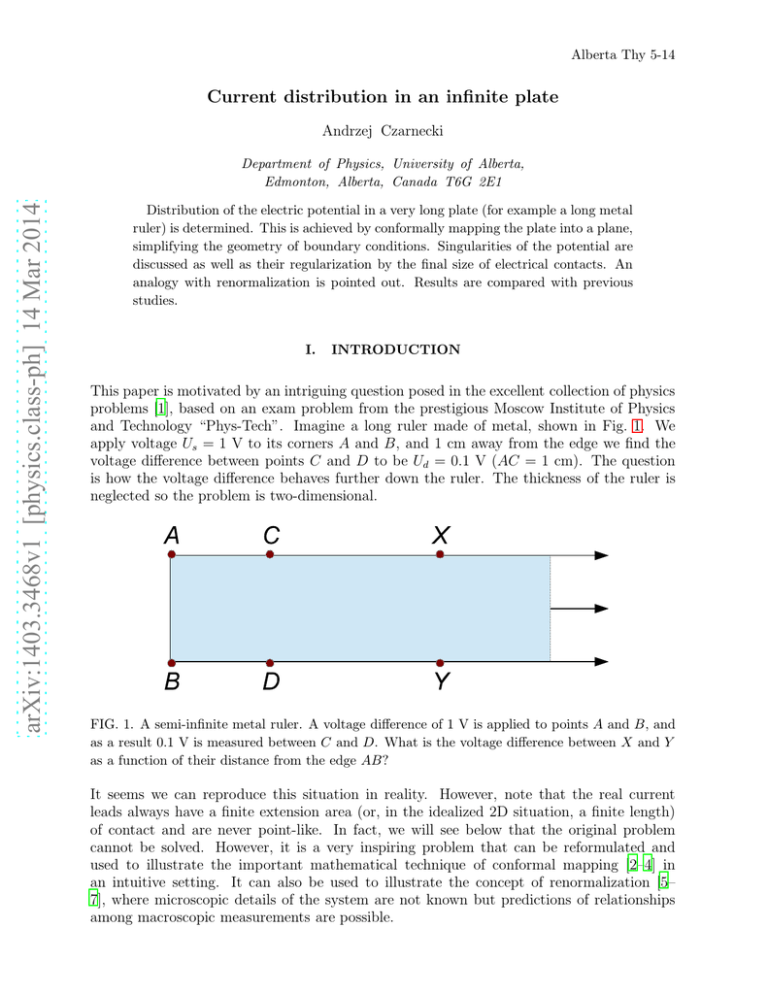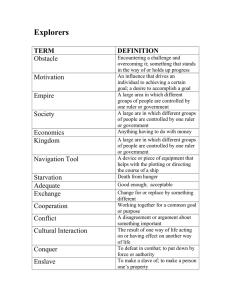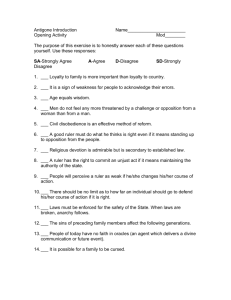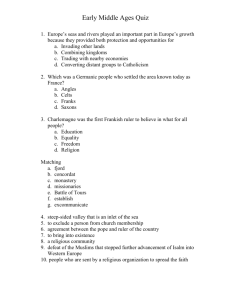Current distribution in an infinite plate
advertisement

Alberta Thy 5-14 Current distribution in an infinite plate Andrzej Czarnecki arXiv:1403.3468v1 [physics.class-ph] 14 Mar 2014 Department of Physics, University of Alberta, Edmonton, Alberta, Canada T6G 2E1 Distribution of the electric potential in a very long plate (for example a long metal ruler) is determined. This is achieved by conformally mapping the plate into a plane, simplifying the geometry of boundary conditions. Singularities of the potential are discussed as well as their regularization by the final size of electrical contacts. An analogy with renormalization is pointed out. Results are compared with previous studies. I. INTRODUCTION This paper is motivated by an intriguing question posed in the excellent collection of physics problems [1], based on an exam problem from the prestigious Moscow Institute of Physics and Technology “Phys-Tech”. Imagine a long ruler made of metal, shown in Fig. 1. We apply voltage Us = 1 V to its corners A and B, and 1 cm away from the edge we find the voltage difference between points C and D to be Ud = 0.1 V (AC = 1 cm). The question is how the voltage difference behaves further down the ruler. The thickness of the ruler is neglected so the problem is two-dimensional. FIG. 1. A semi-infinite metal ruler. A voltage difference of 1 V is applied to points A and B, and as a result 0.1 V is measured between C and D. What is the voltage difference between X and Y as a function of their distance from the edge AB? It seems we can reproduce this situation in reality. However, note that the real current leads always have a finite extension area (or, in the idealized 2D situation, a finite length) of contact and are never point-like. In fact, we will see below that the original problem cannot be solved. However, it is a very inspiring problem that can be reformulated and used to illustrate the important mathematical technique of conformal mapping [2–4] in an intuitive setting. It can also be used to illustrate the concept of renormalization [5– 7], where microscopic details of the system are not known but predictions of relationships among macroscopic measurements are possible. 2 II. ELECTRIC POTENTIAL DISTRIBUTION The electric potential U and the density of current j flowing in the ruler are related by Ohm’s law: the current flows along the gradient of the potential (in an isotropic medium) and the proportionality coefficient is the conductivity σ, ~ ~j = −σ ∇U. (1) ~ · ~j = 0, so, inside the Away from the contact points A and B, the current is conserved, ∇ ruler, the potential satisfies the Laplace equation, ∇2 U = 0. (2) What is the behavior of U near the contact point A? Consider a small circle around A with the radius ǫ much less than the width of the ruler. Since the current is conserved, its density is inversely proportional to the radius of the circle, j ∼ 1/ǫ. We see that j has a pole at A (as well as at B), and the potential has logarithmic singularities at those points. For this reason the problem cannot be solved as originally formulated: if the potential difference at the source Us is finite, the current cannot flow and is zero everywhere, and so is the potential difference between any points further along the ruler, like C and D. If, on the other hand, the potential difference Ud at some distance from the source is non-zero, the source voltage Us must be infinite. In the remainder of this section we will find the potential distribution inside the ruler, assuming infinite Us . In the following section we will use this result to reformulate the problem and make it solvable. The current does not flow across the edges of the ruler, so along the edges the component of the current density perpendicular to the edge vanishes. This is the boundary condition that U must satisfy: the gradient of U must not have components perpendicular to the edges. This boundary problem is much easier to solve a simpler geometry, so we use a conformal mapping to map the ruler into an infinite half-plane. We introduce a complex variable z = x + iy as a coordinate in the ruler: point B (see Fig. 1) is at the origin zB = 0 and the scale is chosen such that point A is at zA = i. If we consider any (twice differentiable) function of z, its real and imaginary components automatically fulfill the Laplace equation (see the Appendix). We now introduce a new complex variable w = exp πz. An important property of such complex mapping is that it preserves angles (see the Appendix). If we find a potential U(w) whose equipotential lines are perpendicular to the images of the ruler boundaries in the mapping w(z), the function U (w(z)) will be automatically the correct solution of our problem in the more complicated geometry of the ruler itself. The image of the ruler under z → w(z) = exp πz is shown if Fig. 2: the current sources A and B are mapped onto two points on the xw axis, wA = (−1, 0) and wB = (1, 0). The long edges of the ruler are mapped onto the infinite parts of the xw axis: the upper edge onto the negative part xw ≤ −1 and the lower one onto the positive part xw ≥ 1. We now see the advantage of using the map w(z): since the sources lie on the wx axis, any function that depends only on the distances from these sources is symmetric with respect to 3 FIG. 2. Image of the ruler in the conformal mapping w(z) = exp πz. If the ruler extended to infinity both to the right and to the left, its image would be the whole upper half-plane Im(w) ≤ 0. The additional, left-hand side half of the ruler would all be mapped onto the unit semicircle around the origin. The curved edge of the semicircle is the image of the edge AB of the ruler. The imaginary u axis is the image of the horizontal symmetry axis of the ruler, Im(z) = 1/2. a reflection in that axis, and lines of its constant real or imaginary part can intersect that axis only at right angles. The horizontal line dividing the original plate in half (Im z = 1/2) is mapped onto the positive imaginary semi-axis. w = 0 corresponds to z = −∞. The solution of the Laplace equation is 2 (xw + 1)2 + yw2 distance from wA = C ln . U (w = xw + iyw ) = C ln distance from wB (xw − 1)2 + yw2 (3) The overall normalization C depends on the amount of current flowing into the ruler and the conductivity. We will discuss its determination below. As we have already noticed, this solution, by symmetry, satisfies the boundary condition that the gradient of the potential at the boundaries of the semi-infinite plate should have no component perpendicular to the boundary (since no current flows through the boundary). In the w plane this is satisfied by (3). Namely, equipotential lines form some closed figures around w = 1 and −1, symmetric with respect to yw → −yw . This shows that they are orthogonal to the upper and lower plates. (It is less obvious that they are also orthogonal to the vertical edge of the plate which is mapped onto a semicircle connecting wA with wB . But they must be, by symmetry (in the z-plane) between the right and the left halves of the infinite plate Im z ≤ 1.) All we now need is to express xw and yw in eq. (3) by the original x, y, xw = exp πx cos πy yw = exp πx sin πy. We find U (x, y) = C ln 1 + 2e−πx cos πy + e−2πx 1 − 2e−πx cos πy + e−2πx (4) (5) (6) 4 and the voltage difference between the upper and the lower edge (y = 1 and 0) is Ux = 4C ln 1 + e−πx → 8Ce−πx −πx 1−e for x ≫ 1/π. (7) We see that far from the edge the voltage drops exponentially and that the exponent does not depend on the resistivity. What sets the scale is the width of the plate (taken here as the unit of length). A. Current density and the normalization We now express the normalization constant C in terms of the current flowing into the ruler. To this end, consider the potential near the origin x = y = 0, U (x → 0, y → 0) = 2C ln 2 , πr The resulting current density is r≡ p x2 + y 2. ~j = 2Cσr̂ , r relating the normalization C to the total current I flowing through the ruler, C= B. I . πσ (8) (9) (10) A model of electrical contacts Suppose the current is supplied to a ruler by contacts that wrap around the corners of the ruler near points A and B in Fig. 1. We assume the length of the contacts to be a small fraction s of the width AB, s ≪ 1. In order to find the resistance between such finite contacts, we divide the ruler into a tiny part between the contact and a quarter-circle of similar size (an equipotential line in case of point-like contacts), as shown in Fig. 3. FIG. 3. A model of a finite contact supplying current to the ruler. The contact is shown with a thick line. The dashed line shows an equipotential line (in case of point-like contacts) of similar length as the real contact. 5 The resistance between the contacts is dominated by the bulk of the ruler between the quarter-circles at both corners; for s ≪ 1, it behaves like ln 1s (see Eq. (8)). The quartercircles themselves have all dimensions on the order of s, so their resistance adds only a constant term to that logarithm and can be treated as a subleading correction. We thus see that the voltage Us applied to the corners is related to the current flowing through the ruler by 4I Us = (c − ln s), (11) πσ where, in the limit s ≪ 1, c is a constant dependent only on the detailed geometry of the contacts but not their size. It is convenient to express the normalization constant of the potential distribution by the applied voltage, Us , (12) C= 4(c − ln s) so that the voltage difference between points on the upper and lower edge of the ruler at the distance x from the left edge is Ux = Us 1 + e−πx ln . c − ln s 1 − e−πx (13) For simplicity, from now on, we assume that the distances from the left edge of the ruler are sufficiently large for the simple asymptotic formula to be valid (this is true for x much larger than about a third of the ruler width), Ux → 2Us −πx e c − ln s for x ≫ 1/π. (14) We now want to use the voltage difference measured at some distance x = d (d equals to the dimensionless ratio AC/AB in Fig. 1), Ud = 2Us −πd e , c − ln s (15) to express the voltage difference at another point at a dimensionless distance x from the edge, Ux = Ud e−π(x−d) . (16) We see that just knowing the source voltage Us and one voltage Ud at some distance from the edge is not sufficient to determine it at other distances. The reason is that there are three unknowns: the width of the ruler W , the size of the contact, and the voltage distribution. Us has the character of an “unrenormalized” quantity whose relationship to physical quantities like Ux depends on the microscopic details of the contacts, parameterized by s and c. However, if we instead know two voltages measured at some distances away from the edge, say D1,2 = d1,2 W , we can find the voltage distribution everywhere (away from the origin). This is because the voltages away from the source depend on one universal combination of the applied voltage and the details of contacts. A new information has been added without increasing the number of given parameters. This leads us to the new formulation of the problem. 6 III. HOW CAN THIS PROBLEM BE FORMULATED If the measured voltage is given at two pairs of points along the ruler, like C, D and X, Y in Fig. 1, it can be found everywhere else. We use the notation D1 = AC, D2 = AX, W = AB; and the distances are expressed in terms of the width, d1,2 = D1,2 /W . We then have Us e−πd1,2 , c − ln s Us Ux = e−πx = Ud1 e−π(x−d1 ) . c − ln s Ud1,2 = (17) It remains to eliminate the unknown width of the ruler using the two given voltages, W =π D2 − D1 U ln Udd1 , (18) 2 and finally x−d1 Ud2 d2 −d1 Ux = Ud1 . (19) Ud1 We have been able to eliminate the unknown microscopic parameters of the problem in terms of the measured macroscopic quantities. It seems that an analytical solution (19) in terms of Ud1,2 is only possible if the asymptotic formula (14) is valid for d1,2 . Otherwise the transcendental equations resulting from (13) have to be solved numerically or geometrically. IV. DISCUSSION OF ANOTHER APPROACH We now want to compare our study with the solution proposed in [1]. The starting point there is a comparison of potential differences Ux at two nearby pairs of points along the ruler, Ux+dx − Ux = α(x)Ux dx, (20) which is certainly true as long as the coefficient α(x) is a function of x. It is then argued that since the ruler is semi-infinite, α(x) = α is a constant independent of the position (as if all points had the same properties). This seems to be wrong, since the ruler is only semi-infinite, so points closer to the left edge are really different from points further down. However, the differential equation thus obtained, Ux′ = αUx , (21) is also satisfied by our asymptotic solution (14). This is because for x ≫ 1 (points far away from the beginning of the ruler), the dependence of α(x) on x becomes very weak. If one treats the equation (21) as valid exactly everywhere, one gets the (incorrect) solution −x/d Us Ux = Us (22) Ud But is this really incorrect? After all, it seems to agree with (19) if we set there d1 → 0. The point is that (19) is not valid unless d1 ≫ 1; it was derived using the asymptotic formula (14). So, one cannot study the limit d1 → 0 with that equation. 7 A. Numerical example Consider two rulers, one with the width W1 = 30 mm, another with W2 = 13 mm, as are typically used in classroom and in the mechanical shop. We use Eq. (13) to adjust contact parameters, c − ln s, to ensure that 1 V supplied to points A and B (see Fig. 1) results in 0.1 V measured 1 cm away from the edge. We find c1 − ln s1 = 7.3, c2 − ln s2 = 1.8. Now, using again Eq. (13), we can determine the voltage difference measured at any distance away from the left edge. Choose the distance equal 20 mm, that is twice the distance where 0.1 V was measured. In the broader ruler we find U1 (20 mm) = 0.03 V, and in the narrower U2 (20 mm) = 0.009 V. For comparison, the incorrect formula (22) gives in both cases 0.01 V, independent of the width. It is accidental that this result is numerically close to that for the 13 mm ruler. For an even narrower one, with W3 = 10 mm, Eq. (22) still gives 0.01 V, while the correct result is 0.004 V. V. SUMMARY Somewhat surprisingly the problem of finding the voltage distribution in a long ruler has turned out to involve some interesting mathematics and physics. We have seen that the solution can be found using a conformal mapping. The procedure is so simple and intuitive that it can be used as a pedagogical illustration of this powerful method of complex analysis. The exact solution with point-like contacts has logarithmic singularities. These are regularized when finite size of contacts is taken into account. Finally, we have found that relationships among measurements away from the contacts can be expressed without reference to the microscopic details, in a way analogous to the renormalization. A solution for a very long ruler, to which the voltage is applied in the middle, rather than at one end, is trivially obtained from the one presented here. Acknowledgments: I thank Alexander Penin and Mikhail Voloshin for helpful discussions. This research was supported by Science and Engineering Research Canada (NSERC). Appendix: Conformal mapping: summary of properties We need two properties of the complex mapping w = w(z) in the present analysis: it is conformal, that is preserving angles at which curves intersect; and it preserves the form of the Laplace equation. The first property follows from w(z) being a differentiable function; that is, its derivative w ′ (z) does not depend on the direction at which z is approached. To see this, consider the three points z0,1,2 and their images w0,1,2 , as shown in Fig. 4. We want to show that the two angles θ and θ′ are equal. The points z1,2 are infinitesimally close to z0 , and for simplicity we choose them to be at equal distance r from z0 . The angle θ is just the difference of phase of z2 − z0 ≡ reiφ2 and z1 − z0 ≡ reiφ1 , θ = φ2 − φ1 = 1 z2 − z0 ln . i z1 − z0 (A.1) 8 FIG. 4. Conformal mapping preserves angles. The angle θ′ is found by expanding w(z1,2 ) − w(z0 ) in a Taylor series; only one term of the expansion suffices since the points are infinitesimally close: 1 w(z2 ) − w(z0 ) ln i w(z1 ) − w(z0 ) 1 w ′ (z0 ) (z2 − z0 ) = ln ′ = θ, i w (z0 ) (z1 − z0 ) θ′ = (A.2) where we have used the independence of the derivative from the direction. Regarding the Laplace equation, it is satisfied by any (twice-differentiable) function of a complex variable z = x + iy, " 2 # 2 2 2 d2 dz dz df d + 2 f (z) = = 0, (A.3) + 2 dx dy dx dy dz 2 2 dz dz 2 + dy = 1 − 1 = 0. Any twice-differentiable mapping z → w(z) preserves this since dx property. [1] S. B. Cahn and B. E. Nadgorny, A Guide to Physics Problems, Part 1: Mechanics, Relativity, and Electrodynamics (Plenum, New York, 1994). [2] J. D. Jackson, Am. J. Phys. 67, 107 (1999). [3] M. A. Furman, Am. J. Phys. 62, 1134 (1994). [4] L. Mittag and M. J. Stephen, Am. J. Phys. 60, 207 (1992). [5] F. Olness and R. Scalise, Am. J. Phys. 79, 306 (2011). [6] B. Delamotte, Am. J. Phys. 72, 170 (2004). [7] L. R. Mead and J. Godines, Am. J. Phys. 59, 935 (1991).


